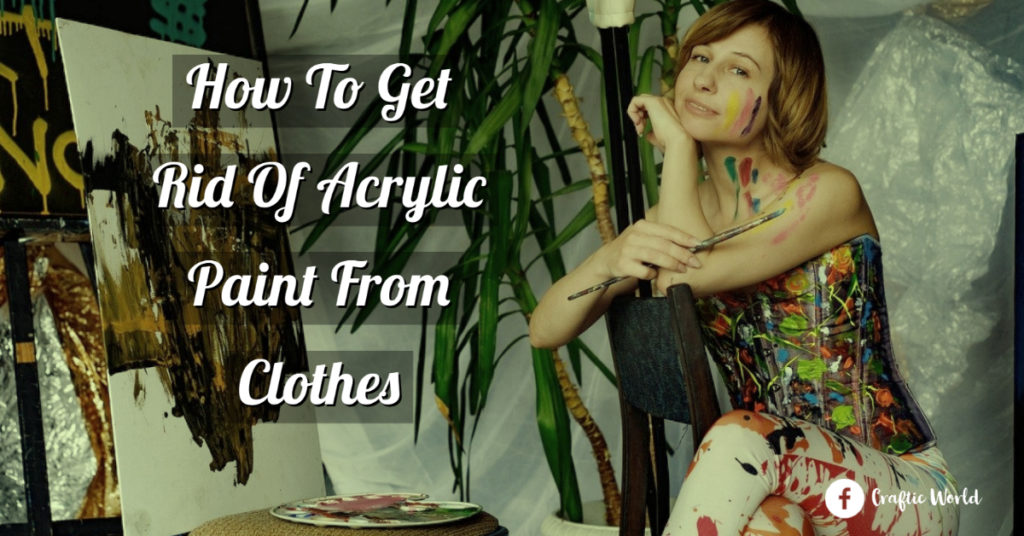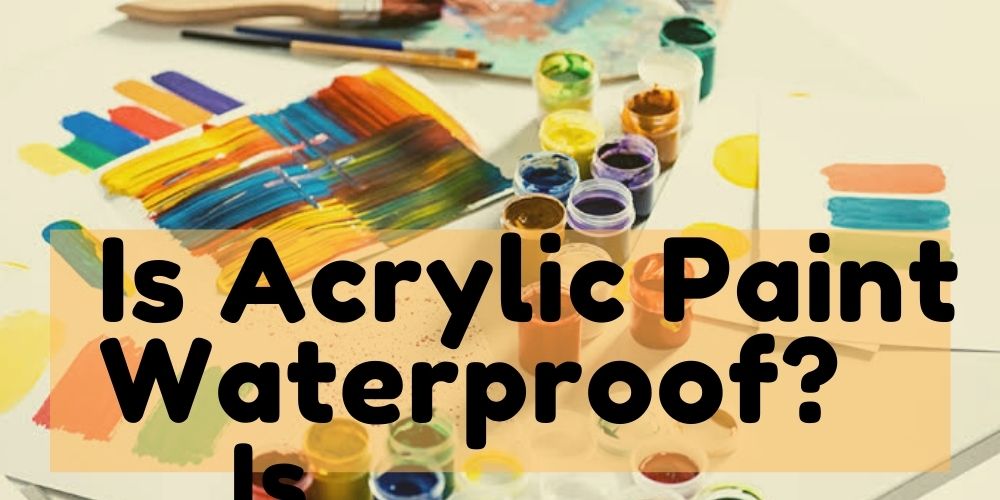Acrylic paint is made of pigment in acrylic polymer emulsion and plasticizers, silicon oils, stabilizers or metal soaps.
But does acrylic paint dissolve in water? Well, it is mostly considered water-soluble, but it also becomes water-resistant when dry. The components of acrylic paints get along very easily with water, so it is advised to mix a certain amount of water before using the paint.
It is largely pigment suspended in a polymer and water. Water is mainly used to thin it.
Acrylic paints are available in all the beautiful colors you want. These are rich in texture and bold as well. Use them carefully and in a balanced quantity with water for their best results.

We mainly use acrylic paints for crafts, decorating, creating beautiful paintings, coloring, and designing clothes. Acrylic paint usually dries up quickly, so one must preserve it perfectly to make the paint last longer. Also, acrylic paints come in various vibrant colors to use all of them together as per your requirements.
Does Acrylic paint dissolve in water?
The short answer is Yes. Acrylic paint is mostly water-soluble when wet because the polymers easily dissolve with water, but it becomes water-insoluble and water-resistant as soon as it dries.
The acrylic paint comprises pigments suspended in acrylic polymer emulsion and plasticizers, silicone oil, deformer, stabilizers or metal soaps. The main reason for the acrylic paints drying fast and preventing the infiltration of the water is the porous nature it possesses.
At the time of drying, the acrylic molecules suspended in the water begin to interlock with each other forming a film over the paint. Eventually, the water evaporates from the pores, and as a result, the paint hardens. This results in the drying of the acrylics in less than thirty minutes.
Acrylics are water-soluble liquid plastic. It mainly constitutes a large amount of pigment suspended in polymer and water. Acrylic paint never completely dissolves, but it is more correct to say that they mix well and stay mixed like dust particles floating in the air without really dissolving.
The super finely ground acrylic pigment particles retain their identity as tiny chunks that float in the water. The particles stay dispersed in water and acrylics, and the acrylic resins that sort of glue the paint together also remain floated as they can mix with water well.
Acrylic is emulsified to make paints. They are not water-soluble. The emulsion can be considered as a secret of latex paints. As soon as they dry, they develop a micro-porous structure, which results from the movement of particulates in the emulsion into the designed-in alignment. The dilatant evaporates, and the film mass increases.
The paint remains water-resistant because the pores are large enough to allow water vapor to pass through and escape but not large enough to allow liquid water to pass.
Why Do You Need to Add Water to Acrylic Paint?
There are too many ways that explain why water is added to acrylic paints. Some of which are provided here to help you out.

Thinner
Water is mainly added to the acrylic paints as it thins the paint, and thinning the paint makes it more spreadable on the surface, giving better coverage. Do not add too much water to the paint as it will lead to discoloration, which will not give the desired result.
Cheap
If we compare the cost of tube colors with acrylics, the latter is way more cost-effective. Tube colors are expensive as one has to pay for the pigment. But in acrylics, one can add water and use less paint in artworks, making it more efficient.
Better Control
Since the paint becomes less dense when mixed with water, it becomes easy to use. Also, one can have better control over his artwork.
Fast Drying
Though Acrylic paints dry fast but using water can quicken the process. It can also be used as customized watercolor.
Why water is not always the best option
Water should not be considered as the only option to mix with acrylics. It is better to use an emulsifier medium than water, like airbrush medium or gloss medium. Medium also gives the paint a good level of thickness and consistency. The main reasons for using emulsifiers instead of water are mentioned below.
How much Water do You Need to add with Acrylic paint?
👍 Some studies suggest not to use acrylic paints with more than 50% water since any more addition of water can cause the polymer in the acrylic paint to break down and lose its qualities. Many manufacturers suggest that 30% of water is the most appropriate quantity to mix with acrylics as 30% water is enough to dilute the paint, neither making it too thin nor leaving the paint very thick.
👍 Acrylic paint with different compositions and consistencies are produced by manufacturing units such as airbrushing highly fluid acrylics to heavy body acrylics. One example of airbrushing acrylics is the sprays, Golden Artist colors products, refillable markers, dip pens, etc. On the other hand, heavy body acrylics have a very smooth texture, thick and buttery consistency. These paints have no fillers, dyes, extenders or toners.
👍 We can choose the acrylic paint as per our convenience, such as your painting style or the surface we are painting.
➤ For a scratchy, textured, uneven look, one can use the dry brush technique, one of the simplest painting methods.
➤ If you need to create layers, washing is one impressive technique to be used as it creates a thin translucent hue effect. This makes it even more beautiful and attractive.
➤ In the case of a landscape painting, you should opt for stripping as it is created through a collection of dots.
➤ For depth effect, one should go with dabbing.
👍 it is not advisable to change the actual structure or composition of the paint by adding water or acrylic emulsion. This will lead to a worsening of the paint, losing its quality and texture, which will further be of no use.
👍 Magna is soluble in spirit water. Magna is a solvent based acrylic color. While some are water based acrylic colors.
What is the Difference Between Acrylic and Water-based Acrylic paints?
Medium
In acrylics, the carrying/binding medium is a mixture of acrylic polymers, a type of plastic and water. In watercolors, the medium is at its most basic: water and gum arabic, and most frequently glycerin. The different mediums determine what supports the paint will bind with.
Surfaces
Acrylics will cling to various surfaces, while watercolors require a porous surface to settle into, so it is required to be careful while choosing the surface when working with acrylics. This should always be kept in mind while working with acrylic colors.
Reactivation
Acrylic paint can’t be reactivated after it dries, but it is water-resistant, and it can withstand a little splash of water, but water-soluble paint can be reactivated after it dries up. This makes the paint more special, so keep it correctly; otherwise, it will be of no use.
Conclusion
Concluding does acrylic paint dissolve in water, we can say that acrylic paints work fine with a desired amount of water, but the quantity of increased water percentage can ruin the paint, not only in terms of its quality but also its structure. Thus, water, acting as a thinner, has its desirable effects on the paints.
The paints should be used as per the instructions mentioned by the manufacturers as an additional amount of water can lead to over-thinning of paint, asking it to lose its adhesiveness and quality. The paint should also not be left to dry up as it cannot reactivate its properties back.
If you find any more questions related to this article, comment in the comments section below and let us know.



